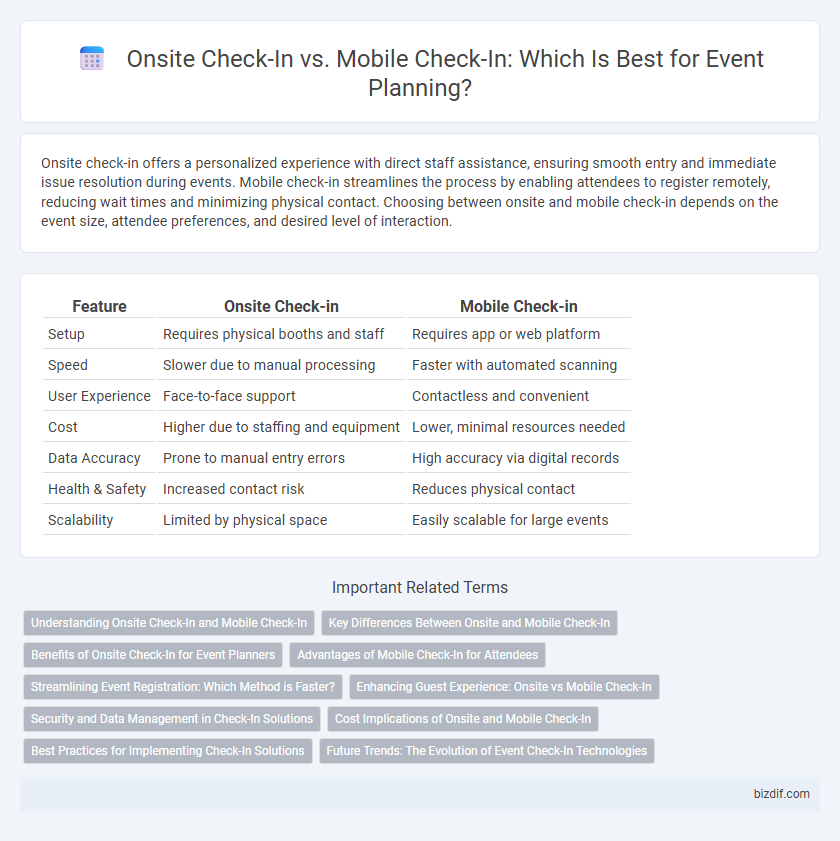Onsite check-in offers a personalized experience with direct staff assistance, ensuring smooth entry and immediate issue resolution during events. Mobile check-in streamlines the process by enabling attendees to register remotely, reducing wait times and minimizing physical contact. Choosing between onsite and mobile check-in depends on the event size, attendee preferences, and desired level of interaction.
Table of Comparison
| Feature | Onsite Check-in | Mobile Check-in |
|---|---|---|
| Setup | Requires physical booths and staff | Requires app or web platform |
| Speed | Slower due to manual processing | Faster with automated scanning |
| User Experience | Face-to-face support | Contactless and convenient |
| Cost | Higher due to staffing and equipment | Lower, minimal resources needed |
| Data Accuracy | Prone to manual entry errors | High accuracy via digital records |
| Health & Safety | Increased contact risk | Reduces physical contact |
| Scalability | Limited by physical space | Easily scalable for large events |
Understanding Onsite Check-In and Mobile Check-In
Onsite check-in involves attendees registering at a physical location upon arrival, streamlining badge printing and verification processes with dedicated staff and equipment. Mobile check-in leverages smartphones and tablets, allowing attendees to self-register through apps or QR code scanning, significantly reducing wait times and enhancing event flow. Both methods improve accuracy and data collection, but mobile check-in offers greater convenience and efficiency by minimizing physical contact and resource requirements.
Key Differences Between Onsite and Mobile Check-In
Onsite check-in requires attendees to physically register at a designated location, often leading to longer wait times and the need for more staff resources, whereas mobile check-in leverages smartphone technology, enabling faster, contactless registration directly from attendees' devices. Mobile check-in integrates seamlessly with event apps and real-time data updates, improving accuracy and enhancing the overall attendee experience. Onsite check-in remains essential for verifying IDs and handling last-minute changes, but mobile check-in significantly reduces congestion and operational costs.
Benefits of Onsite Check-In for Event Planners
Onsite check-in offers event planners real-time control over guest registration, ensuring immediate problem resolution and personalized attendee interaction. This method enhances data accuracy by verifying identities on the spot and reduces no-show rates through direct engagement. Furthermore, onsite check-in streamlines event flow, minimizing bottlenecks and improving the overall attendee experience.
Advantages of Mobile Check-In for Attendees
Mobile check-in streamlines the event entry process by allowing attendees to bypass long queues and complete registration instantly using smartphones, enhancing convenience and reducing wait times. It supports contactless interaction, promoting health safety and minimizing physical touchpoints, which is crucial in post-pandemic event environments. Real-time updates and seamless integration with event apps improve attendee engagement and provide personalized event experiences.
Streamlining Event Registration: Which Method is Faster?
Mobile check-in significantly accelerates event registration by enabling attendees to check in using their smartphones, reducing wait times and minimizing the need for physical staff. Onsite check-in, though traditional, often leads to longer queues due to manual badge printing and verification processes. Integrating mobile check-in technology streamlines the registration workflow, enhancing overall event efficiency and attendee experience.
Enhancing Guest Experience: Onsite vs Mobile Check-In
Onsite check-in offers personalized assistance and immediate issue resolution, enhancing guest satisfaction through face-to-face interaction. Mobile check-in streamlines the process by reducing wait times and allowing guests to check in remotely, increasing convenience and efficiency. Combining both methods optimizes the guest experience by balancing human touch with technological innovation.
Security and Data Management in Check-In Solutions
Onsite check-in systems offer controlled environments that reduce risks of data breaches through secured network setups and direct staff oversight. Mobile check-in solutions utilize encrypted data transmission and cloud-based storage to manage attendee information securely, enabling real-time updates and minimizing physical contact points. Both methods require robust authentication protocols and compliance with data protection regulations like GDPR to ensure attendee privacy and secure data management during event registration.
Cost Implications of Onsite and Mobile Check-In
Onsite check-in typically incurs higher costs due to the need for additional staff, physical equipment rental, and space allocation, which can significantly increase overall event expenses. Mobile check-in reduces these costs by leveraging attendees' devices and automated software, minimizing staffing and hardware needs while streamlining the registration process. Event planners can optimize budgets by adopting mobile check-in solutions, which also enhance efficiency and reduce wait times.
Best Practices for Implementing Check-In Solutions
Implementing onsite and mobile check-in solutions requires seamless integration with event management software to ensure real-time data synchronization and minimize attendee wait times. Optimal practices include pre-event testing of hardware and software, clear signage, and training staff to assist attendees effectively while maintaining data privacy compliance. Leveraging mobile check-in can enhance speed and convenience, whereas onsite check-in offers personal interaction, so combining both methods tailored to the event size and profile maximizes efficiency and attendee satisfaction.
Future Trends: The Evolution of Event Check-In Technologies
Onsite check-in remains reliable for large-scale events, but mobile check-in leveraging QR codes and NFC technology is rapidly gaining traction due to its speed and contactless convenience. Future trends indicate widespread adoption of AI-driven facial recognition and biometric authentication, enhancing security and reducing wait times significantly. Integration with event apps and cloud-based platforms enables real-time data synchronization, providing organizers seamless attendee management and personalized experiences.
Onsite check-in vs Mobile check-in Infographic

 bizdif.com
bizdif.com